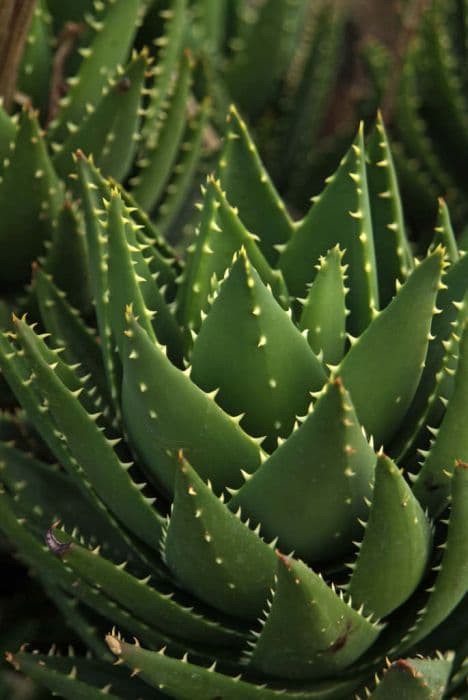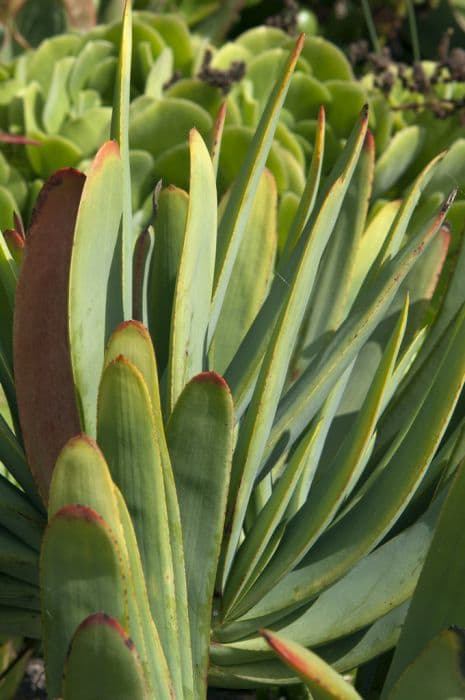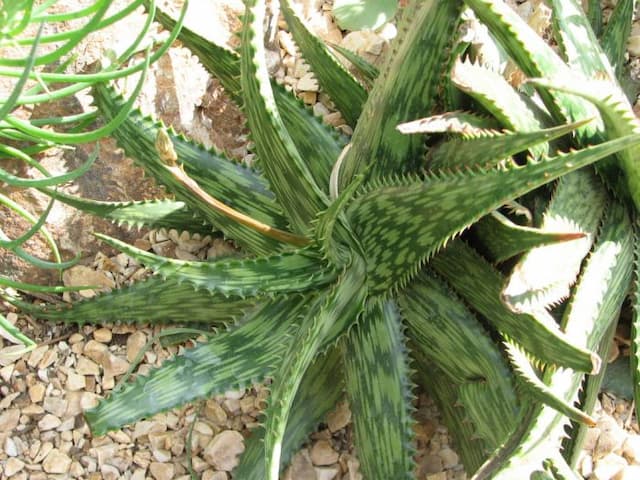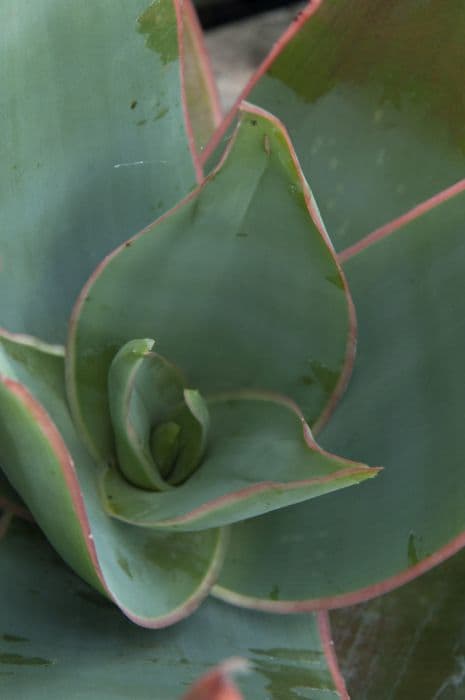Red hot poker Kniphofia 'Sunningdale Yellow'

ABOUT
The 'Sunningdale Yellow' is a vibrant perennial plant known for its striking flower spikes. This plant produces robust spires that bloom with yellow flowers, exuding a warm, sunny hue. Each spike is densely packed with tubular florets, which transition from a richer, buttery yellow at the base to a paler yellow at the tips, creating a gradient of color as they rise upwards. These blooms are particularly attractive to hummingbirds and pollinators, who are drawn to their vivid color and nectar. The foliage of the 'Sunningdale Yellow' consists of long, slender leaves that arch gracefully from the base, resembling a lush green fountain. The leaves are a bright green, creating a beautiful contrast with the yellow flower spikes that emerge above them. In full bloom, the plant boasts a rich tapestry of greens and yellows, adding a warm, tropical feel to any garden setting. The overall appearance is one of visual warmth and sunshine, a popular choice for gardeners looking to inject a splash of color into their landscapes.
About this plant
 Names
NamesFamily
Asphodelaceae.
Synonyms
Red Hot Poker, Torch Lily, Tritoma.
Common names
Kniphofia 'Sunningdale Yellow'
 Toxicity
ToxicityTo humans
The plant commonly known as Red Hot Poker is not widely considered toxic to humans. There's limited information on severe reactions from ingestion of this plant. However, like with many plants, it might cause mild stomach upset if ingested in large quantities. It's always best to err on the side of caution and not consume parts of ornamental plants without confirmation of their edibility.
To pets
Red Hot Poker is not typically listed as a toxic plant to pets. While it is not usually harmful, it's possible that a pet could experience mild gastrointestinal upset if they ingest part of the plant. As with humans, it is recommended to prevent pets from eating ornamental plants to avoid potential issues.
 Characteristics
CharacteristicsLife cycle
Perennials
Foliage type
Evergreen
Color of leaves
Green
Flower color
Yellow
Height
3 feet 2 inches (96 cm)
Spread
2 feet (60 cm)
Plant type
Herbaceous
Hardiness zones
6
Native area
South Africa
Benefits
 General Benefits
General Benefits- Attracts pollinators: The bright yellow flowers of the Red Hot Poker are appealing to bees, butterflies, and hummingbirds.
- Drought tolerance: Once established, it can tolerate periods of drought, making it suitable for water-conservative gardens.
- Low maintenance: This perennial requires minimal care once it is established, other than occasional deadheading and division.
- Long blooming period: It has a lengthy flowering season, often from early summer to autumn, providing long-lasting color in the garden.
- Architectural interest: With its tall flower spikes and grass-like foliage, it adds vertical interest to garden beds and borders.
- Deer resistance: Red Hot Poker is not a preferred choice for deer, making it a good option for gardens in areas with deer populations.
- Versatility: It can be planted in a variety of garden styles, including cottage gardens, coastal gardens, and contemporary landscapes.
 Medical Properties
Medical PropertiesThis plant is not used for medical purposes.
 Air-purifying Qualities
Air-purifying QualitiesThis plant is not specifically known for air purifying qualities.
 Other Uses
Other Uses- Artistic photography subject – The striking yellow blooms of the Kniphofia 'Sunningdale Yellow', commonly known as Red Hot Poker, serve as a vibrant subject for botanical photographers and artists looking to capture the beauty of unique garden plants.
- Floral arrangements – Fresh or dried, the long spires of Red Hot Poker can be used in floral arrangements, adding height and a pop of color to bouquets or indoor displays.
- Educational tool – Horticulture educators can use the Red Hot Poker to demonstrate plant adaptation and survival strategies, such as its deeply set roots that store water to survive in hot, dry climates.
- Mood enhancement – Due to its bright flowers and unique appearance, the Red Hot Poker can be planted in gardens or used in green spaces to create a cheerful ambiance and improve overall mood.
- Garden design – Can be used as a focal point in xeriscaping due to its drought resistance, adding visual interest to water-efficient garden designs.
- Erosion control – The robust root system of the Red Hot Poker helps stabilize soil, making it a practical choice for planting in erosion-prone areas.
- Biomimicry inspiration – Designers and engineers can study the structure of the Red Hot Poker for biomimicry applications, such as replicating its spike-like flower for efficient water collection systems.
- Theme gardens – Red Hot Poker can be included in fire-themed gardens due to the flame-like appearance of its flowers, complementing other plants with red, orange, and yellow color schemes.
- Attracting wildlife – When planted in the garden, Red Hot Poker attracts hummingbirds, bees, and butterflies, supporting local biodiversity and providing opportunities for wildlife observation.
- Culinary experimentation – Although not a common practice, the Red Hot Poker's nectar-rich flowers could potentially be used for culinary experimentation in syrups or unique garnishes, taking caution as the plant is not generally known for edible use.
Interesting Facts
 Feng Shui
Feng ShuiThe Red Hot Poker is not used in Feng Shui practice.
 Zodiac Sign Compitability
Zodiac Sign CompitabilityThe Red Hot Poker is not used in astrology practice.
 Plant Symbolism
Plant Symbolism- Attraction: Kniphofia, commonly known as Red Hot Poker, draws attention with its bright, fiery blooms, symbolizing allure and magnetism.
- Standing Out: Its distinctive flower spikes make it standout in a garden, which can symbolize uniqueness or standing tall in a crowd.
- Warmth: The warm yellow color of 'Sunningdale Yellow' is reminiscent of the sun, often symbolizing warmth, happiness, and positivity.
- Vitality: The robust nature and hardiness of the plant are reflective of good health and vitality.
 Water
WaterRed hot poker plants, including the 'Sunningdale Yellow', require consistent moisture, especially when in bloom and during hot, dry periods. Water this perennial deeply once a week, providing about 1 inch of water which translates to approximately 0.6 gallons per square foot. It's important to avoid overhead watering to reduce the risk of fungal diseases. Instead, use a soaker hose or drip system for deep watering that keeps the foliage dry. During the winter, reduce watering significantly as the plant requires a drier dormant period.
 Light
LightRed hot poker plants flourish in full sun, receiving at least 6 hours of direct sunlight a day. Position 'Sunningdale Yellow' in a location where it will receive unfiltered sunlight to promote the best flowering and health of the plant. Avoid planting in heavily shaded areas, as this will diminish blooming and can lead to poor growth and health.
 Temperature
TemperatureThe 'Sunningdale Yellow' red hot poker thrives in a wide range of temperatures but prefers the warmer range of 50°F to 90°F. It's hardy and can survive minimum temperatures down to around 0°F, but for optimal growth, maintain the temperature above freezing. Be cautious of extreme cold, which can damage or kill the plant.
 Pruning
PruningPrune 'Sunningdale Yellow' red hot poker plants to remove spent flower stalks and encourage a second bloom. Cut the stalks down to the plant's base using clean, sharp shears. Perform this pruning shortly after the flowers fade, usually in late summer. Additionally, in early spring, tidy up the plant by removing any dead or damaged foliage to maintain its appearance and health.
 Cleaning
CleaningAs needed
 Soil
SoilRed Hot Poker thrives in well-draining, sandy soil with moderate fertility. The ideal pH for cultivating Kniphofia 'Sunningdale Yellow' is between 6.0 and 7.0. A mix composed of two parts garden soil, one part sand, and one part compost or aged manure would create an optimal growing environment.
 Repotting
RepottingRed Hot Poker does not require frequent repotting and prefers to be left undisturbed. Repotting every 3-4 years or when it is evident that the plant has outgrown its current pot is sufficient for maintaining its health.
 Humidity & Misting
Humidity & MistingRed Hot Poker is adaptable and does not require specific humidity conditions. It naturally thrives in average outdoor humidity levels, typically preferring dry conditions over excessively humid environments.
 Suitable locations
Suitable locationsIndoor
Place in bright light, avoid overwatering, and provide good air circulation.
Outdoor
Plant in full sun, well-drained soil, and space them 18 inches apart.
Hardiness zone
5-9 USDA
 Life cycle
Life cycleKniphofia 'Sunningdale Yellow', also known as the Torch Lily, begins its life cycle as a seed, which when sown, gradually germinates depending on soil temperature and moisture levels. The seedling then emerges and develops into a young plant with a rosette of narrow, grass-like leaves. As the plant matures, it develops a strong root system and in spring to early summer, it sends up a flower spike adorned with tubular yellow flowers that attract pollinators. After pollination, if successful, the flowers will produce seed pods that eventually dry and release seeds to propagate the next generation. During winter or in colder climates, the Torch Lily may enter a period of dormancy, where growth slows down or ceases, and the plant conserves energy for the next growing season. In subsequent years, the plant continues to grow larger, producing more flower spikes each season, and the cycle repeats until the plant's eventual senescence and death.
 Propogation
PropogationPropogation time
Spring-Early Summer
Propogation: Kniphofia 'Sunningdale Yellow', commonly known as Red Hot Poker, is typically propagated through division, which is the most popular method. The best time to divide and propagate this perennial is in the spring, after any danger of frost has passed and just as new growth begins to emerge. To divide the plant, carefully lift it from the ground with a spade, taking care not to damage the root system. Using a sharp knife or spade, cut the clump into smaller sections, ensuring that each section has at least one growth point or fan of leaves. Replant the divisions at the same depth they were growing originally, spacing them about 18 inches (approximately 45 centimeters) apart to allow for proper growth. Water the newly planted divisions well to help establish them. This method allows the gardener to increase their stock of Red Hot Pokers while rejuvenating older clumps that may have become too large or crowded.









